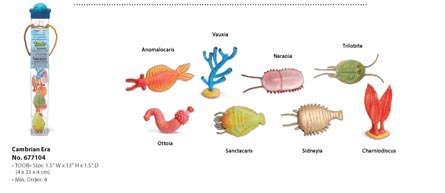The Worm that Walked Tall – Diania cactiformis
Approximately 520 million years ago (Middle Cambrian), slowly stalking its way across the muddy seabed of what was to become the Yunnan province of southern China was a strange worm-like creature that had ten pairs of partially-jointed, armoured legs. This peculiar creature, just one of many bizarre Cambrian animals, may represent the type of transitional animal between soft-bodied, legless worms and the armoured arthropods such as trilobites, crabs and lobsters.
Bizarre Cambrian Animals
The creature has been named Diania cactiformis it may have only been six centimetres long, but this is quite a large size when compared to other animals that existed at the time or indeed when compared to older fossil organisms from the Burgess Shale locations.
Nick-named the “walking cactus”, this animal seems to have a distinctive head, or at least one end of it ended in a swollen bulbous appendage that may have been the site of sensory organs. The creature’s remains were discovered in 2006, in Cambrian aged strata in the county of Chengjiang in southern China’s Yunnan province. Chinese palaeontologists from the country’s Northwest University found the fossil and have ascribed it to the Lobopodia, a long-extinct group of organisms that outwardly resemble worms with legs. Diania cactiformis differs from other members of the Lobopodia by seeming to have spiny, armoured legs.
The discovery and research into this ancient creature has been documented in the latest edition of the scientific publication “Nature”. Dr Liu Jianni, leader of the research team from the Northwest University expressed excitement at having had the opportunity to study what may be an extremely important fossil, helping to explain the evolution of hard-bodied animals from soft-bodied animals during the early Phanerozoic.
Bizarre Cambrian Animals
It is thought that the bulbous appendage seen in the top left of the picture represents the head end, but scientists remain uncertain with regards to the exact anatomical structure of this strange creature. The head reminds us at Everything Dinosaur, of the bizarre structure to be found at one end of that famous Burgess Shale animal – Hallucigenia. Whether Hallucigenia actually had a head is open to debate, the head-like structure on the fossils found may not be related to the specimen at all, but fossils of this animal, classified as an arthropod have been found in China. Perhaps, this walking cactus is related to Hallucigenia in some way.
Diania cactiformis
Looking like a 520-million-year-old pressed flower, the fossil of Diania cactiformis is very well preserved and the spiky appendages on the leg-like structures can clearly be made out. This animal may have walked tall across the muddy sediments at the bottom of the shallow sea that covered China. It may hold the key to the development of the Arthropoda a huge Phylum that contains something like 80% of all known living species.
The arthropods show great diversity and morphology and includes the crustaceans, insects, millipedes, spiders, scorpions and trilobites.
Commenting on the discovery, Professor Shu Degan, head of the Northwest University’s Early Life Institute commented on the evolution of the leg-like structures:
“With these appendages, arthropods were able to run faster, jump higher and move with more agility. Some appendages even evolved into preying instruments. They helped arthropods become powerful and eventually dominant members of marine, freshwater, land and air ecosystems.”
To view models of ancient prehistoric creatures: Wild Safari Prehistoric World Figures.







Leave A Comment